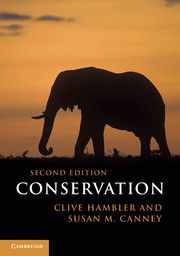Book contents
- Frontmatter
- Contents
- Preface to the Second Edition
- 1 Introduction to conservation
- 2 Threats to biodiversity
- 3 Evaluation of priorities for species and habitats
- 4 Monitoring and Environmental Impact Assessment
- 5 Management of natural and fragmented habitats
- 6 Management of species
- 7 Sustainable use, semi-natural cultural landscapes and the matrix
- 8 Restoration and offsetting
- 9 Environmental policy
- References
- Index to species names
- Index
- Plate section
8 - Restoration and offsetting
Published online by Cambridge University Press: 05 February 2013
- Frontmatter
- Contents
- Preface to the Second Edition
- 1 Introduction to conservation
- 2 Threats to biodiversity
- 3 Evaluation of priorities for species and habitats
- 4 Monitoring and Environmental Impact Assessment
- 5 Management of natural and fragmented habitats
- 6 Management of species
- 7 Sustainable use, semi-natural cultural landscapes and the matrix
- 8 Restoration and offsetting
- 9 Environmental policy
- References
- Index to species names
- Index
- Plate section
Summary
Some sites that have already been damaged still retain valuable features and threatened species. There is increasing interest in rebuilding such communities to a state more like the natural community. We will firstly consider the history, value and targets of restoration, before considering re-introductions, control of invasive species and methods for particular habitats. We will then consider issues surrounding mitigation and offsetting, and how to confirm successful restoration.
Restoration has been defined as ‘any active attempt to return an ecosystem to an earlier condition following degradation resulting from any kind of disturbance’ (Welch & Cooke, 1987). The principles of restoration can also be used to minimise impact when land use is changed, for example when planning conversion to agriculture. The long established concept of restoration has to some extent recently been rebranded as ‘rewilding’, which can involve numerous and often visionary and controversial re-introductions of regionally extinct species. Environmental education (Section 9.2.3) will be important in restoration to help explain the management aims and the changes anticipated in the landscape – including species losses.
There is a further impetus to the science and methodology of habitat restoration. If habitats can be restored in their original location, then perhaps they can be restored elsewhere? Restoration management and translocation management have been embraced by developers aiming to ‘offset’ impacts by a form of compensatory payment-in-kind, using methods often presumptuously described as ‘mitigation’ (Section 8.6). There are many potential risks should we become overconfident that habitats and species that are in the way of a development can be replaced or exchanged through such ‘biodiversity offsets’.
- Type
- Chapter
- Information
- Conservation , pp. 271 - 308Publisher: Cambridge University PressPrint publication year: 2013



